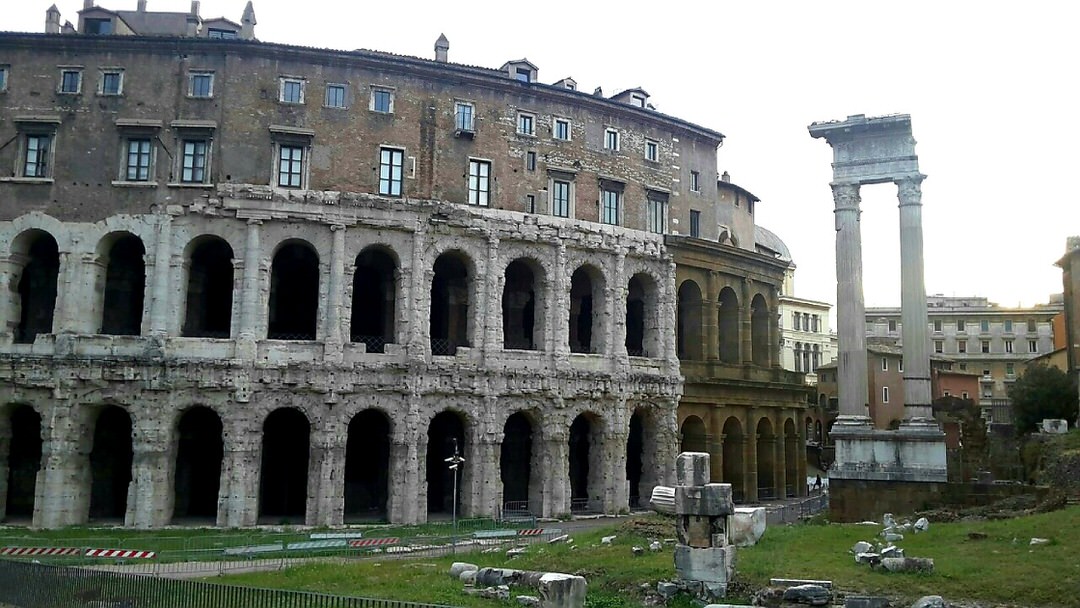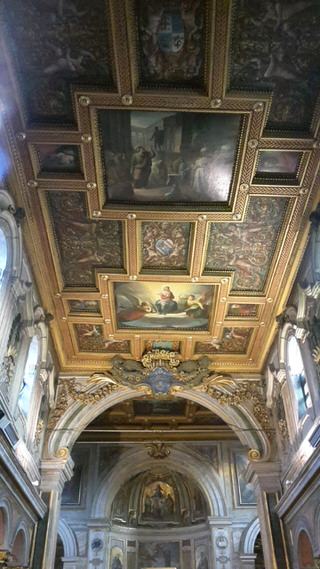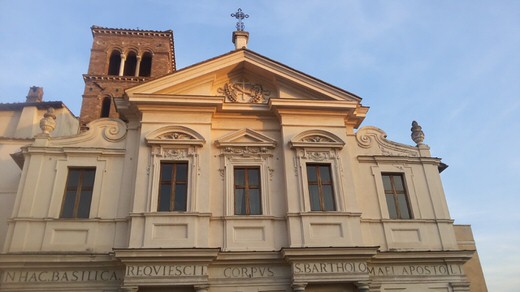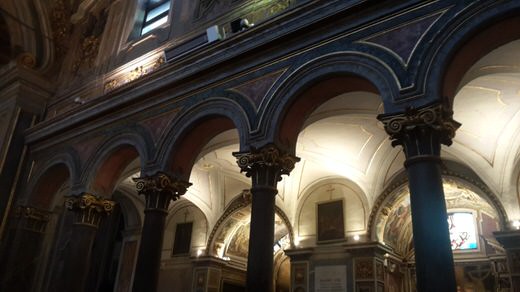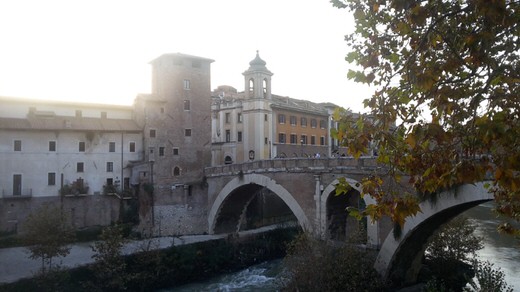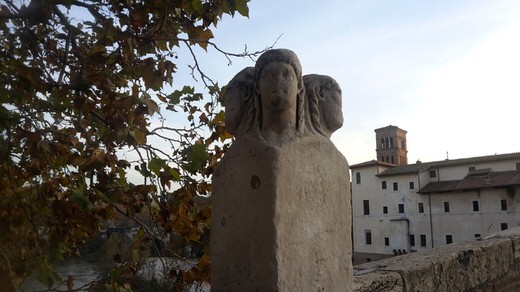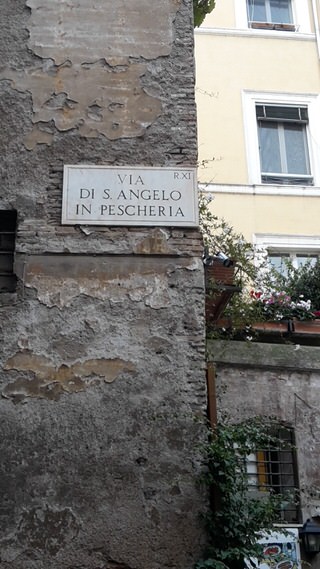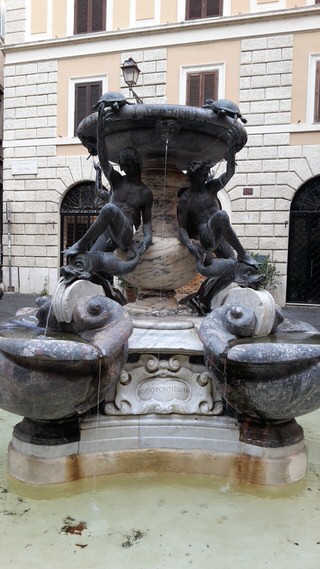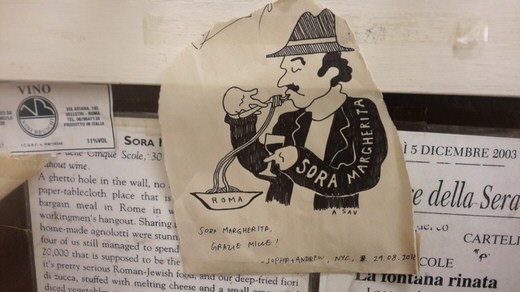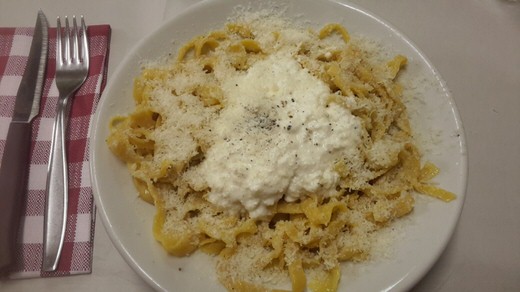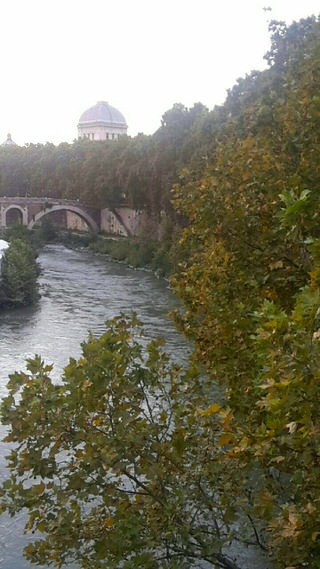Everyone who visits the Eternal City soon becomes well aware of the fact that every step and every walk is a path that travels you back in history, a history evident and alive everywhere you turn your sight at. And what’s even more fascinating is that almost every sight gives you the chance to observe the influence and marks of different historic periods, artistic movements, purposes and intentions of built, changes of use and so ultimately, a whole historic layering is unfold in front of your eyes. This is one of the characteristics that makes Rome such a unique and astonishing city: the relentless narration of its well preserved history by the city itself, which accompanies you throughout your entire journey.

The area of Forum Boarium that embraces the old Jewish Ghetto and spreads all the way to Tiber’s little island, is a perfect example of living history from ancient to medieval times. And though it might not be as well known and glamorous as other parts of the city, it’s full of archaeological treasures and well preserved remains of architectural masterpieces.
This walk will allow you to explore the area of the ancient market of Rome, the oldest forum that was the center of the commercial activities, and will lead you to the neighborhood of one of the oldest Jewish communities in the world.
From the Capitoline hill to the Theatre of Marcellus

You can start your walk from the edge of the Capitoline hill, the busy hub of Piazza D’ Aracoeli. Leaving the Piazza behind you , take Via del Teatro di Marcello and head south. This way, you’ll have the Capitoline hill on your left and the Ghetto area to your right. After a few minutes walk, you’ll be in the area of the ancient fish market, the Forum Piscarium.
A narrow street remains of the 210 BC commercial structure, where fishermen traded their products, a market that was later incorporated into another indoor market area that also hosted the fruit and vegetable traders. You can recognize the area by the few elegant columns that remain from the ancient Roman Temple of Apollo Sosianus, which you can observe carefully later, when you’ll explore the Ghetto area. And can you see the beautiful, arched, open air theatre that resembles the Colosseum? It’s the Teatro di Marcello, the popular Theatre of Marcellus one of the largest and most important theatres of the times of the Roman Republic. It was inaugurated by Emperor Augustus in 12 BC who named it after his beloved nephew and most possibly his successor, Marcellus, who had died a decade ago.
In the days of its glory the exemplary building could host up to 20.000 spectators. You can still observe the Greek order of the columns, of Doric style at the lower level, Ionic in the middle and presumably Corinthian at the top level which today doesn’t remain, as the upper tier of seatings and columns were removed in the Middle Ages, when the treatre was turned into a fortress and later a residence passing to the possession of the Pierleoni, Savelli and Orsini families. These days, apart from being able to visit the archaeological site, if you happen to be in Rome during summertime, you can also attend one of the summer concerts and music festivals that are being held at the ruins of the treatre, a truly unique cultural experience.
Where ancient Romans held their commercial activities

At this point you could go around Teatro di Marcello and find yourself in the area that used to be the Jewish Ghetto, but I suggest you keep walking along Via del Teatro di Marcello and explore more of the exciting area of the ancient markets. So right after the ancient treatre, the area of the Forum Holitorium appears in front of you, the remains of the ancient oil market of Roman times. Apart from the market itself, the complex was completed by four temples of the Republic times, but unfortunately what remains of them today lies beneath or is incorporated into the Church of San Nicola in Carcere. Taking its name from a former prison that stood there ( carcere=prison ), it’s a small church worth visiting for the chance to clearly see the ruins and columns of three temples built into its walls. Notice the Renaissance facade by Giacomo della Porta and follow the small staircase under the altar, that will take you to the temples’ base.

If you would like to see some more remains of the Foro Olitorio, then cross the street at this point and you’ll see the Portico al Foro Olitorio, the entrance to the ancient oil market. Very close to it stands the Church of Sant’Omobono with the area next to it being the site of the oldest known temples’ ruins in Rome. The street behind the church, Piazza della Consolazione, will take you to another evidence of the area’s past: Arco Di Giano, the large four-gated Arch of Janus. Although beautifully decorated and adorned with statues, its purpose was not to glorify the achievements and victories of an emperor but a more humble one. That was merely to provide shelter from bad weather conditions to the cattle traders and their animals.
You are now standing in what used to be the ancient Forum Boarium, the market that once was so lively and where sheep farmers and animal breeders would daily sell their animals. Crossing the street with the heavy traffic towards the Tiber, will bring you right in the center of this ancient market, Piazza della Bocca della Verita.
The monuments that frame Piazza della Bocca della Verita
In this small park you can admire two of the best preserved ancient temples. The rectangular one, Tempio di Portuno, is the marvelous Temple of Portunus or Temple of Fortuna Virilis as it’s mostly known since Renaissance times. Portunus was the god of ports and rivers and that explains the temple’s location so close to the river banks. Its excellently preserved state is due to its conversion into a church, with its elegant Ionic columns being incorporated to the churches’ walls. The second temple is the gorgeous, round Tempio di Vesta that was dedicated to the mythological god Hercules Olivarius, who protected oil and animal traders. It owes its name to its resemblance with the temple of the same name in the Roman Forum and its perfectly preserved condition is again due to its conversion into a worship place. This beautiful and elegant temple with more than 20 Corinthian columns dates from the 2nd century BC and is the oldest marble building to have survived in Rome.
Stay in Piazza della Bocca della Verita for a while and observe the small for Roman standards, baroque fountain, Fontana dei Tritoni. Right opposite it, on the other side of the road, the 7 levels high medieval bell tower – the tallest in Rome – belongs to the beautiful church of Santa Maria in Cosmedin, very popular among tourists due to the myth that follows one of its main attractions. Bocca della Verità, or The Mouth of Truth, is a huge ancient, marble drain cover or mask, depicting the sea god Oceanus, perfectly preserved and situated in the portico of the church. Since 1953 when it appeared in the famous film “Roman Holiday“, it keeps drawing in crowds who reluctantly put their hands into the mask’s open mouth. The legend has it that Oceanus will eat any liar’s hand, so go ahead if you dare! Unfortunately, most visitors of the church only go as far as the legend and miss the artistic treasures and architectural beauty of this 8th century church. It was originally built as a diaconate with the purpose of distributing food to the poor and was also the center of the Greek community in Rome. Its name “Cosmedin” refers to the Greek word “cosmidion” which translates “adornment” and indeed the church is wonderfully decorated with precious and rare floor mosaics of the Cosmati technique. This elaborate stone work of white, red and green marbles dates back to the 12th century, depicts stars and other geometrical patterns and is of particular artistic value. The same technique is applied in the big Easter candlestick close to the red granite main altar. If you happen to be in Rome in mid February, you’ll see St Valentine’s crowned skull which is kept in this church, adorned with flowers.
The Tiber, its small island and the ancient bridges
If you return now to the area of Forum Boarium, you can cross the bridge Ponte Palatino and enjoy the wonderful view towards the small island Isola Tiberina and just next to it the ruins of Ponte Rotto, the Broken stone bridge, that was build in the 2nd century BC in order to connect the ancient market area with Transtevere. Walking along the river banks will reward you with stunning views of the big southern bend of Tiber, especially in the hour that the sun begins to set and will allow you to get a good idea of the size of the picturesque boat-shaped island.
Crossing Ponte Cestio will take you right in the center of the small island with the long history, associated with an ancient temple of Asclepius, the Greek god of medicine and healing, who helped the city of Rome overcome a plaque epidemic. Fate Bene Fratteli hospital now occupies the largest part of Isola Tiberina and the place of the ancient temple has been taken by the church of San Bartolomeo all’Isola, which is worth visiting. In front of the church a small guglia, a sculptured obelisk like the ones you see outside churches in Naples, occupies a small piazza, while the interior contains the relics of St. Bartholomew which are kept inside an ancient Roman porphyry bathtub. And that’s not the only ancient, preserved element inside the church, where fourteen also ancient Roman columns frame the nave.
When you exit the church and before leaving the island, notice the tower that stands over the churches’ baroque facade which is the only part remaining from the medieval castle Torre dei Gaetani. From this point, crossing Ponte Fabricio will make you feel like you’re following the steps of ancient Romans who were using this bridge, Tiber’s oldest one, since 62 B.C. when it was originally built.
A walk in the heart of the Jewish Rome
You are now entering the Ghetto, the center of one of the oldest Jewish communities in the world, as the Great Synagogue on your left indicates. It’s a neighborhood full of history, a place of memory, rich in culture, vibrant and picturesque and especially ambient as night falls. In order to study the history of the Jewish community a visit to the Museo Ebraico di Roma, housed inside the Great Synagogue complex, will reveal many aspects of the religious and social life in the ancient Jewish quarter. Hundreds of fabric and silverware exhibits tell a tragic story, from 1555 when a papal edict restrained the Jewish to only living within the Ghetto walls and excluded them from certain occupations, to the horrific racial persecutions of World War II.
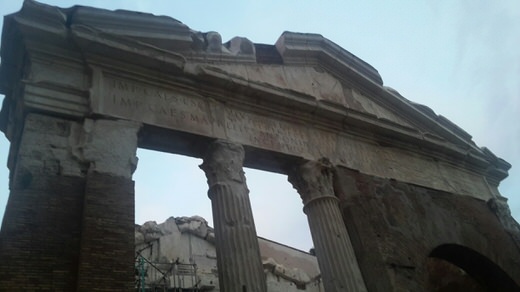
Having become acquainted with the area’s history, it’s now time to explore the picturesque lanes, streets and squares that form a labyrinth, so welcoming and charming that you can spend hours just wandering around. Via del Portico d’ Ottavia is the main street that runs the heart of the area and combines ancient ruins and kosher restaurants that celebrate authentic, traditional, Roman-Jewish cuisine.
First of all, notice Portico d’ Ottavia itself, the remains of an ancient colonnaded walkway that used to enclose two temples and a library and was dedicated by emperor Augustus to his sister, Ottavia. You can carefully walk among the ruins that offer a great view towards both Teatro di Marcello and Temple of Apollo Sosianus which you saw previously, in the beginning of your walk. Walk all the way towards the three columns that survive to full-height today, of what was a glorious temple combining the name of god Apollo to whom it was dedicated, with the name of Gaius Sosius, the Roman general that was responsible for the temple’s final rebuilt. Having now a clear image of the extent of this ancient area, you can realise its greatness since the Republican era and for so many centuries since. The later use of the portico area as a fish market in the medieval period is evident in the name of the annexed church of Sant’Angelo in Pescheria ( pescheria=fish market ). It’s a church modest in appearance, dating back to the 8th century, which has undergone many restorations and is of significant historic importance, as it was there where in 1347 Cola di Rienzo retired in recollection before his effort to seize control of Rome .
Back to Via del Portico d’ Ottavia, for a walk along some of the most renowned Roman restaurants with Jewish dishes, such as the famous Giggetto that serves specialties like Carciofi ala Guidia, Crocchette di baccala and Fiori di zucchina, deep fried artichokes, cod fish croquettes and stuffed, fried courgette flowers, that you simple have to try. If you can hold your appetite until dinner time, keep walking along the same street and just give in to a little snack: Either a delicious ice cream from Gelateria Steccolecco, where you can enjoy a light fruit sorbet or ice cream stick ( the Biscotto is fantastic! ), or a Jewish pastry from Pasticceria Boccione. This bakery that was established in 1815, is well known among locals and much loved for its kosher sweets, especially the Pizza Ebraica, a sweet bread filled with toasted almonds, pine nuts, marzipan, maraschino cherries and raisins.

Exiting the bakery, turn right on the picturesque Piazza Costaguti in order to start exploring the labyrinth of alleys that form a charming frame. Let this street lead you to Via dei Felegnami, a quiet street full of small shops, and head eastwards until you hear the sound of splashing water interrupting the area’s tranquility.
The Mattei family leaves its mark in the Ghetto area
It’s Fontana delle Tartarughe, an elegant Renaissance fountain in Piazza Mattei, one of Rome’s most picturesque squares. The sculptural complex of marble, travertine and bronze depicts a happy scene of four young boys sitting above shell shaped small tubs, playing with dolphins and turtles, that give the fountain its name. Payed by nobleman Muzio Mattei for being placed in front of his house and designed by Giacomo della Porta, the project was completed by the sculptures of Taddeo Landini and later on by Bernini, who added the four turtles on the edge of the upper tank. The fountain stands in the middle not only of Piazza Mattei, but also of an area called Isola Mattei because of the total six residences that the Mattei family of bankers and politicians owned in this block. The most impressive of them, Palazzo Mattei, was commissioned to Carlo Maderno and was home to a notable art collection.
From Piazza Mattei where you’re now standing, try to locate and follow the narrow alley called Via della Reginella where you can see the now closed entrance of Palazzo Costaguti , then return to Fontana delle Tartarughe and walk along Via dei Funari, the street named after the rope makers who had their workshops there, heading east. This is one of the most imposing parts of the Ghetto, as the numerous palaces confirm.

Indeed, if you turn left on Via Caetani, as soon as you see Santa Caterina dei Funari, the church with the elaborate bell tower, you’ll come across the gorgeous Palazzo Mattei di Giove, a monumental palace that is certainly the most impressive of all Mattei residences and in my opinion is one of the most beautiful buildings in Rome. Built according to Carlo Maderno’s designs and featuring two courtyards and two loggias, it’s richly decorated with statues, busts and reliefs of emperors, creating an overall stunning impression of an open museum. Today it houses the Center for American studies as well as the Library of Modern and Contemporary History and you can freely wander around its charming courtyards and pergolas.

The small squares that hide big treasures
Return on Via dei Funari where you’ll come across another palace, Palazzo Caetani Lovatelli, on the top of whose porticos you can read the inscription that mentions the two families’ names: CAETANI one of the oldest Roman families and LOVATELLI who bought the palace in the 19th century. From Piazza Lovatelli keep walking along Via dei Funari until you find the small square called Piazza di Campitelli, with the imposing baroque church of Santa Maria in Campitelli or Santa Maria in Portico, from the Portico d’ Ottavia that is close. Carlo Reinaldi who made the designs, came up with a travertine two-storey facade, underlined by pillars and vertical lines. The church was built in the purpose of housing a small, miraculous icon of Virgin Mary with the child, that when was carried in procession through the streets, it played a role in saving the city from a plague epidemic. You can now admire it in the church’s main altar, bathed in light and surrounded by golden decorations of high altar’s glory.
Heading towards the back of the church you’re realise you’re just a few steps from Portico d’ Ottavia and you’ll reach Ghetto’s main thoroughfare again. Let Via del Portico d’ Ottavia lead you westwards to the tiny Piazza delle Cinque Scole with the marble fountain, Fontana del Pianto. The square derives its name from the five Jewish schools that operated there and the main reason you shouldn’t miss it is the fantastic, traditional trattoria Sora Margherita. For many years it used to be the locals’ safely kept secret, without even a sign outside its door, a delicious destination only for the ones in the know. But, wold of mouth made its reputation grow and visitors of this small, unpretentious place are now dining surrounded by photos of devoted funs from all over the world, like former U.S.A. president, Bill Clinton.
The strictly homemade pasta like fettuccine, ravioli and agnolotti is fantastic, definitely try the cacio e pepe with extra ricotta cheese, a deeply tasty dish! The meatballs in rich tomato sauce will have you licking your fingers, while other traditional dishes worth trying are lamb scottadito, the coda alla vaccinara and since you’re dining in the Ghetto, the artichokes alla Giudia are the star of appetizers. And once you’ll try it i’m sure you’ll agree with me, that there wouldn’t have been a better way to end your meal than a generous slice of homemade tiramisu. Enjoy the vivid atmosphere and indulge in their authentic delicacies without guild, because you certainly deserve it after such a long walk!

